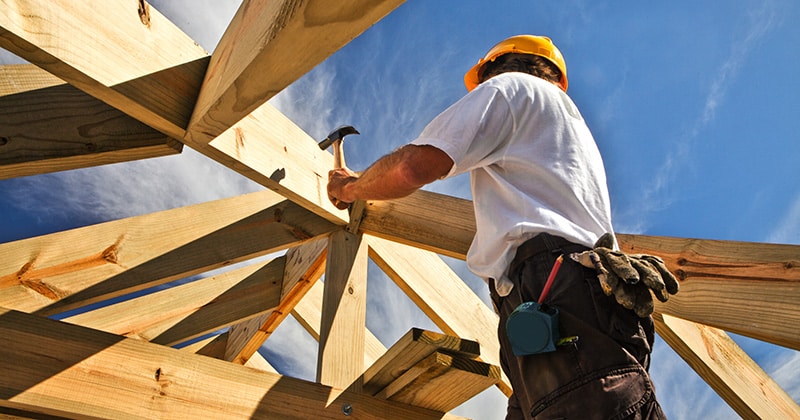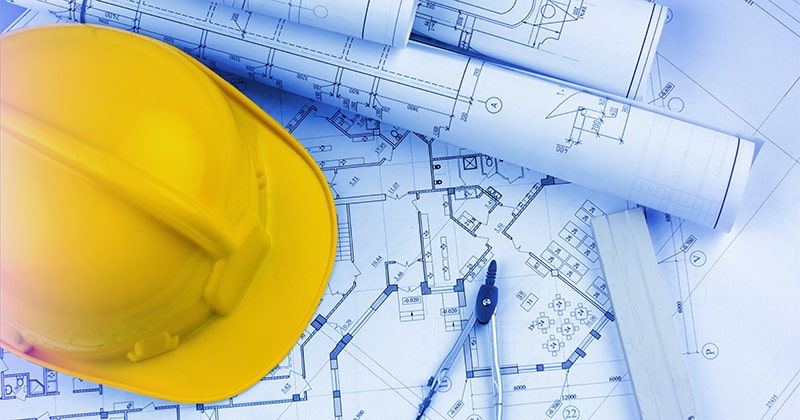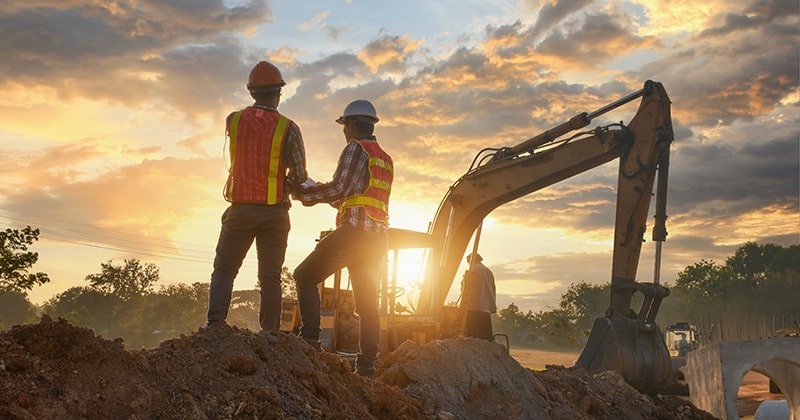Commercial Construction vs. Residential Construction: 6 Differences You Should Know
Residential projects and commercial construction projects are very different. Materials, project timelines, and budgets all vary. Which business model will help you be profitable?

Staff Contributor
Construction is the building of any type of structure. But when it comes to the actual building process, two distinct categories emerge. Residential and commercial construction.
Residential projects and commercial construction projects are vastly different. Most construction companies are set up to offer one or the other.
To help you understand the distinction, we’re unpacking residential vs. commercial construction. Read on to learn the characteristics of residential and commercial projects and how the work differs.
What Is Residential Construction?

Residential construction is the building of properties intended to be lived in. Think single-family homes and apartment buildings. According to IBISWorld data, there are 378,036 home builders in the US.
Residential construction projects include new builds. Alterations and repairs also fall under the umbrella of residential services. Basically, if you’re working on or building people’s homes, you’re in residential construction.
What Is Commercial Construction?
Commercial construction accounts for another huge chunk of the construction industry. It’s more diverse than the residential construction industry because it encompasses a greater variety of projects and clients.
It also includes some of the largest construction companies in the country. Companies like Whiting-Turner, DPR Construction, and Gilbane.
These mega companies each generate billions in revenue. They have the capacity to take on complex commercial projects. Large manufacturing facilities and shopping centers, for example.
Commercial construction services involve the building, repair, and alteration of structures meant for commercial purposes. So if you’re building properties designed to make money, you’re in commercial construction.
Examples of Residential vs. Commercial Properties

When looking at residential vs. commercial projects, the main distinction is intent.
- Residential properties are for living.
- Commercial properties are for making money.
As such, examples of residential properties include:
- Single-family homes
- Mobile homes
- Townhomes
- Student housing
- Multi-family houses, such as duplexes and triplexes
- Apartment buildings
Commercial property examples include:
- Doctor’s offices
- Retail shops
- Restaurants
- Office buildings
- Manufacturing plants
- Warehouses
- Storage units
But what about residential properties that generate income, such as apartment buildings and even single-family homes rented out to tenants?
When it comes to categorizing for construction purposes, single-family homes are always considered residential. It doesn’t matter if the property is owned by the occupier or an investor.
Residential living buildings might be classed as commercial construction projects. Whether they’re residential or commercial depends on their size.
For example, the US Department of Labor categorizes all apartment buildings and multi-family buildings with four floors or less as residential. Once the structure has more than four floors, it’s a commercial building.
Examples of Common Residential vs. Commercial Construction Projects
Home builders and general contractor businesses usually focus on residential construction projects. Here are some examples of the type of projects a residential construction company offers:
- Custom home builds
- Kitchen and bathroom renovations
- Home extensions
- Outdoor construction projects, including decks, patios, and accessory dwelling units (ADUs)
- Home repairs
- Home remodels
Because commercial building includes everything from hotels to manufacturing plants, the projects tend to be complex, take longer to complete, and are expensive.
Common commercial projects include building, renovation, and repair work for:
- Schools
- Medical facilities
- Office buildings, including everything from small office space to high rises
- Sports facilities
- Food services buildings
- Shopping malls
- Grocery stores
- Libraries
- Factories
6 Differences Between Residential and Commercial Construction Services

The reason that residential and commercial construction are considered to be separate industries goes far beyond the purpose of the building. Every facet of the construction process is distinct.
Here’s how.
1. Building Materials
Because individual households or investors pay for residential projects, there are limits as far as what people can afford. This simple fact impacts the types of materials you’ll find in the buildings.
For example, most houses have timber frames. Timber is affordable. It offers the structural stability that’s appropriate for a single-family house, a townhome, or a duplex.
Commercial buildings are generally taller. They might have a unique architectural style that requires an extremely durable frame. That’s why most commercial projects involve steel.
Steel is stronger than wood. It also costs more, but because commercial projects are funded by companies or investors, there’s more room in the budget for higher-priced materials.
Residential projects are also more straightforward in terms of the layout and standard materials used. A home will have a kitchen, bathrooms, bedrooms, and shared living spaces. And so you’ll see the same general materials: wood, cement, vinyl, stone, drywall, and insulation.
Commercial projects are far more complex and varied. You might need a wider range of building materials. You also might need specific equipment to incorporate architectural details.
Factors such as more stringent insulation requirements and soundproofing can also play a bigger role in commercial projects.
Commercial building owners might want innovative or sustainable building materials that don’t fit within the typical homeowner’s budget. Think switchable smart glass windows, self-healing concrete, and wool bricks.
You’ll get:
- More variety
- More intensive needs
- Bigger material budgets
That means the companies offering these services have to build wider supplier networks. They also need more highly skilled labor.
And, they have to stay on top of building material trends so they can offer the best options to meet their commercial clients’ needs.
2. Commercial vs. Residential Construction Project Timeline
Another big difference between residential and commercial construction services is the timeline.
Residential projects take less time. It takes about seven months to build a single-family home from the ground up. A small apartment building takes closer to a year to build.
Complex commercial projects can take even longer because of the need for more planning stages before getting started.
Some buildings, such as hospitals, data centers, and manufacturing plants, might also incorporate specialized systems, which will add to the construction timeline.
The following are the norm in the commercial construction industry:
- Building automation
- Commercial-grade ventilation systems
- High-performance electrical systems
All these features make a project take longer.
Because commercial projects are so expensive, it’s vital to follow a tight project deadline.
You’re paying more for skilled laborers, construction professionals, and equipment. When you tally everything up, a commercial project can cost a small fortune. And every day the costs go up astronomically.
That’s why you’ll find construction project managers working extremely hard to meet a strict project timeline.
Residential projects aren’t as time-stressed. A few extra days aren’t going to make a huge impact, in most cases.
3. Construction Costs
Residential construction costs are more predictable. They’re also more manageable.
- The materials typically cost less.
- Labor doesn’t need to be as specialized.
- The size of the project is typically modest.
A homeowner or investor will have a set budget in the thousands or hundreds of thousands of dollars.
Commercial projects, on the other hand, can range from millions to hundreds of millions of dollars.
Here’s another way to look at the cost difference: The average cost of a new house is $150 per square foot. Commercial properties cost several hundred per square foot.
- A five-star hotel can cost as much as $871 per square foot.
- A regional mall will cost $554 per square foot.
4. Building Permits
When you construct a new building or add on to an existing one, you’ll need to ensure you’re meeting all required building codes. You’ll also apply for any necessary building permits before getting started.
Building codes exist to protect the general public and anyone inhabiting a building.
Permits for residential projects are usually straightforward.
- The project needs to have appropriate electrical and plumbing systems.
- The size, design, materials, and construction techniques need to follow local codes.
The US has adopted the International Building Code (IBC) for electrical, plumbing, and mechanical systems.
Depending on where you’re building, you might also need to follow state and city-specific building codes. For example, San Francisco requires all new builds to follow the Green Building Code.
Commercial structures must adhere to standard codes. They also have to meet safety and design requirements for architectural details, such as the following:
- Elevators
- Balconies
- Parking lots
- Commercial kitchens
- Swimming pools
There’s more complexity and more rules to follow. As a result, the projects will take more time.
5. Construction Equipment
Larger projects usually require more sophisticated equipment. You might have to rent cranes, bulldozers, and concrete mixers.
Compactors, loaders, and other heavy machinery are commonly found on commercial project sites. So common, in fact, that larger commercial companies might decide to buy the equipment. That way, they always have it on hand.
Residential projects still involve heavy machinery. But only for a short period of time.
Let’s say you’re building a new home. You might use a heavy-duty compactor to prepare the earth before laying a concrete foundation. As the site is small, you’ll only need it for a few hours.
A commercial site would use a compactor for several days.
Because they need fewer machines for less time, residential companies might only rent their equipment.
Why invest in trucks and earthmovers that cost hundreds of thousands of dollars? If your residential company only uses them for a couple of days each month, you would rent not buy.
6. Project Payment and Cash Flow
Residential companies will have a higher quantity of projects than commercial companies. Also, each one is completed in a relatively short amount of time.
For example, a residential company’s workload might look like this:
- Complete a kitchen renovation in two weeks
- Install a new patio in a couple of days
- Renovate a home in a few months
Clients will usually pay for some of the cost upfront. Then the full payment comes when the project is completed.
Residential construction companies always have new projects coming in. They aren’t vulnerable if a project falls through or if a client pays late.
Commercial companies might spend more than a year on one project. You’ll have higher labor and material costs, so you can’t necessarily afford to wait for late payments from clients.
Also, when the economy slows, commercial projects are often put on hold. This could put your business at risk.
Residential or Commercial: Which Business Model Is Right for You?

Residential and commercial construction both involve building and renovations. But that’s where the similarities end.
Residential construction is a more accessible market sector. You can expect:
- More affordable building materials
- A larger market
- Simpler equipment and labor needs
Commercial construction is more complex. But for well-run companies, the sky is really the limit. Leading businesses bring in billions in revenue each year.
What’s important to remember is that every construction business started somewhere. So all you need to do is take those first steps forward. Here’s what you can do to get things going:
- Sketch out your 10-year business plan. Your plan doesn’t have to be set in stone. Right now you’re just brainstorming.
- Research three to five existing construction companies in your preferred niche. Do you see your business matching their success?
- Schedule an appointment with a business consultant. Outside insight can steer you in the right direction.


